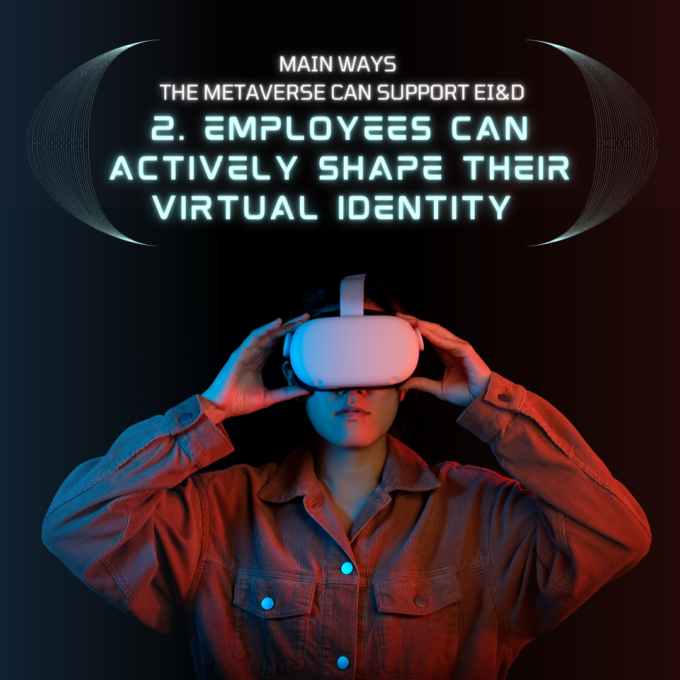
Fix the system, not the women
It’s time to debunk outdated myths around women lacking confidence and not asking for pay rises and focus on the real problem: societal misperceptions. ...

by Alyson Meister Published 3 November 2023 in Diversity, Equity, and Inclusion • 6 min read
Your organization may not yet be active in the virtual workspaces of the metaverse, but for most it is only a matter of time. What’s more, executives are coming around to the idea; according to one survey, 78% of business professionals say they would readily participate in the immersive work experiences offered by the metaverse, with as many as 87% saying they would be comfortable conducting HR meetings in a virtual space.
As organizations begin to use metaverse platforms and virtual reality (VR) meeting spaces, it is important for them to consider the implications for diversity, equity, and inclusion (DE&I) and to set expectations among users about how they should behave in these new arenas. If they fail to acknowledge the responsibility that comes with this opportunity, the creators of these virtual spaces could find themselves ‘baking in’ problems that will be hard to unwind. However, if they define these spaces responsibly, businesses could find the metaverse to be a powerful lever for creating truly inclusive organizations.
There are three main ways in which the metaverse can support DE&I.
Metaverse technology can help eliminate some biases in how people interrelate by removing the visual cues that people use unconsciously to stereotype and categorize people. This could be particularly valuable in recruitment. Businesses have invested substantial amounts in training employees to recognize and avoid those biases, yet study after study indicates that hiring managers retain unconscious biases, regardless of retraining. In the metaverse, this can be mitigated by stripping away some of the information that perpetuates such biases.
Technology can also help improve recruitment inclusivity by removing certain barriers that would dissuade certain people from applying in the first place. For example, metaverse technology could help people with some physical disabilities in terms of access, or those who suffer social anxieties around in-person contact, such as neurodiverse individuals, by allowing them to expose themselves as much or as little as they wish.
The metaverse gives people the opportunity to recreate themselves and even customize their identity – to ‘try on’ and present distinct versions of themselves that may be difficult to access in the physical world (for example, in relation to gender or skin color.) The metaverse can allow people opportunities to represent themselves in a way that they feel is more ‘accurate,’ and more closely aligned with their sense of self.
CEOs may reflect that this runs contrary to the popular notion that employees should be ‘authentic’ and bring their ‘whole selves’ to work. In reality, this should not cause too great a concern because creating a different virtual identity is not an easy task. In addition, early studies in this field suggest a high level of congruence between people’s actual selves and how they present their avatars in the metaverse. People still conform to certain contextual expectations and norms – dressing professionally, for instance. Their gender identity, color, and hair type typically remain consistent. However, there may be a slight self-enhancement bias – smoothing out one’s skin, changing one’s age, or even taking on different personality traits.



When employees collaborate in VR spaces represented by avatars, they are able to connect regardless of geographical, cultural, or linguistic restrictions, with the shared aim of solving a particular problem. Their avatar can put everyone ‘on the same foot’ when it comes to identity – once the familiar cues of cultural, gender, or age-based stereotyping biases have been covered up, coworkers are able to focus on the ideas put forward rather than being distracted by the identity of the person who has proposed them.
Additionally, when people collaborate in virtual spaces, it can eliminate exclusion created by situations where some attendees are physically present and some have joined remotely – a common scenario in the post-pandemic hybrid working environment.
For all the potential upsides of using virtual workspaces, there are potential downsides. The emergence of the metaverse creates new ways for human behavior – positive and negative – to play out.
Firstly, the metaverse exposes users to the possibility of virtual harassment, trolling, and bullying. Platforms are extremely difficult to regulate; one study, carried out in Facebook’s VR Metaverse, recorded 100 potential policy violations during just 11.5 hours of use. When platforms are used within organizations, the challenges are different, but employers should still ensure they put measures in place to keep their people safe, especially if they have to rely on platform providers that are still getting to grips with the dangers themselves.
The second potential drawback relates to access. How can organizations offer inclusive access to the metaverse in the first place? Just as it is hard for people with lower socioeconomic status to access higher levels of education, there are likely to be challenges to their accessing the metaverse. Will diverse businesses across the world be able to access it, or will there be a paywall that only wealthier businesses can scale?
There is a further question about potential discrimination against individuals who are not ‘digital natives.’ As organizations engage with the metaverse, they need to consider not only access, but the democratic availability of the skills required to negotiate this new environment productively.
It is abundantly clear that the metaverse has huge potential to impact on DE&I, both for good and ill. There are four key points that CEOs should consider to ensure a positive impact on their organizations.
The key principle is that DE&I must be built into the frameworks in which virtual spaces operate. As the metaverse is still being built, organizations have a unique opportunity to create a world that is fair by design. This will not happen by accident – it needs to be the product of positive action. Every aspect of the metaverse should be designed with DE&I in mind. It will be far more difficult to reverse engineer systems if and when problems emerge than to anticipate those problems with built-in solutions.

There are encouraging moves in this space. In 2022, the World Economic Forum launched a new initiative, Defining and Building the Metaverse, to focus on the governance of the metaverse and how it can be developed in safe, secure, interoperable and inclusive ways.
Cross-silo enterprise leadership will be essential to ensuring that the metaverse is designed with DE&I in mind; this cannot be an afterthought or simply left to HR. Rather, organizations need to ensure that voices with experience and insight into DE&I policy, interpersonal behavior, and bias mitigation are heard whenever a key decision is about to be made, including product-related decisions. That may mean upskilling people in two directions: helping technical and product experts better understand DE&I issues and helping people with DE&I expertise understand the fast-evolving world of technology.
As organizations enter virtual spaces, they should actively monitor and regulate a range of factors linked to DE&I, including psychological safety and guarding against trolling or bullying. This is not just a challenge for platform providers; organizations need to recognize their obligations to protect employees in virtual spaces, just as they would in any other work environment.
Although the metaverse is inherently part of the new world of work, it doesn’t mean that it will automatically imbue its users with a sense of inclusion. Organizations must ensure that they engage in and reinforce inclusive leadership practices, which are as applicable in VR as anywhere else.
It is inevitable that human behavioral dynamics – good and bad – will play out in these new virtual spaces. Cliques will form, exclusive attitudes will emerge, bad behavior and bullying will occur. But organizations have a unique opportunity to design the metaverse in ways that minimize the potential for these negative behaviors and mitigate the harm they can cause. If CEOs ensure they design for DE&I, organizations can use the new virtual reality to help create a fairer world.

Professor of Leadership and Organizational Behavior at IMD
Alyson Meister is Professor of Leadership and Organizational Behavior and Director of the Future Leaders program at IMD Business School. Specializing in the development of globally oriented, adaptive, and inclusive organizations, she has worked with of executives, teams, and organizations from professional services to industrial goods and technology. She also serves as co-chair of One Mind at Work’s Scientific Advisory Committee, with a focus on advancing mental health in the workplace. Follow her on Twitter: @alymeister.

27 October 2023 • by Ginka Toegel in Diversity, Equity, and Inclusion
It’s time to debunk outdated myths around women lacking confidence and not asking for pay rises and focus on the real problem: societal misperceptions. ...

9 October 2023 • by Natalia Olynec, Lars Häggström in Diversity, Equity, and Inclusion
With a growing number of employees holding their organizations to account over sustainability commitments, the onus is on HR departments to explain a firm’s purpose and impact if they are to attract...

9 October 2023 • by Martina Fuchs in Diversity, Equity, and Inclusion
Executives must do more to change the balance of power in the workplace, says BLM co-founder...

5 October 2023 in Diversity, Equity, and Inclusion
Despite progress in the fight for gender equality, the gap remains large. This article identifies what can be done. ...
Explore first person business intelligence from top minds curated for a global executive audience